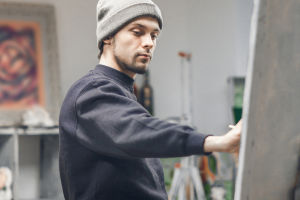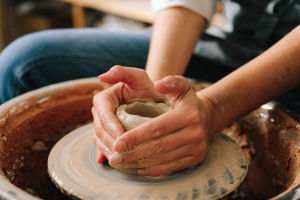In recent years, digital art has risen to prominence, marking a revolutionary shift in the art world. No longer confined to traditional canvases, art is now being created, bought, and sold in virtual spaces.
This digital transformation is driven by advancements in technology, the rise of NFTs, and the increasing use of digital platforms to showcase and monetize artwork.
For those of us who have grown accustomed to physical art galleries and framed paintings, the rise of digital art can be hard to grasp. However, as digital creations gain traction, we begin to see how this medium is redefining the very concept of art.
The Emergence of Digital Art
Digital art refers to artwork created using digital tools, such as computers, tablets, and software. While the concept of digital creation is not new, its mainstream popularity has soared in recent years. Artists are using advanced software like Adobe Photoshop, Procreate, and Blender to craft intricate pieces that range from 2D illustrations to 3D animations. The appeal of digital art lies in its flexibility—artists can create pieces without the constraints of physical materials or the messiness of traditional mediums.
For us, the ability to edit, alter, and experiment with designs in ways that were never before possible is incredibly empowering. No longer do we need to worry about running out of paint or buying new brushes. With digital art, the only limitation is our imagination.
NFTs: Changing the Game
One of the most significant shifts in the art world has come with the rise of NFTs, or Non-Fungible Tokens. NFTs are digital certificates of ownership for a piece of art, stored securely on the blockchain. They guarantee the authenticity and ownership of a digital work, similar to how a certificate of authenticity might accompany a traditional painting.
NFTs have enabled us to buy, sell, and trade digital art just as we would physical art. Some of the highest-profile sales have included NFTs that sold for millions of dollars. For example, Beeple's digital collage, "Everydays: The First 5000 Days," sold for a whopping $69 million at Christie's auction house, illustrating the massive potential for digital art in the marketplace.
What makes NFTs so attractive to both collectors and artists is that they offer a way to prove ownership and ensure artists are compensated each time their art is resold. We are no longer relying on galleries or physical spaces to verify and promote artwork. The virtual world has become our new gallery, and blockchain technology ensures that the ownership of art can be tracked and transferred easily and securely.
The Impact on the Art Market
The introduction of NFTs has reshaped how we buy, sell, and collect art. No longer limited by geography, we now have the ability to access global art markets with just a few clicks. Digital art platforms like OpenSea, Rarible, and SuperRare offer a marketplace for artists to showcase their work and for collectors to invest in unique pieces. This has democratized art in ways that traditional art markets never could.
In the past, art collectors had to physically visit galleries or auctions to view and acquire pieces. With the advent of digital platforms, the art world has become more accessible than ever. We can now browse thousands of pieces of digital art, explore the stories behind them, and make purchases from the comfort of our homes.
How Digital Art Challenges Traditional Concepts
One of the most interesting aspects of digital art is how it challenges our traditional notions of what art should be. Traditionally, art has been about rarity, craftsmanship, and physical presence. Digital art, however, can be reproduced infinitely, making it "unlimited" in one sense. This creates an interesting paradox—while digital art can be easily copied, NFTs ensure that each piece has a unique, verifiable ownership history, making it as valuable as its physical counterparts.
For some of us, this new approach to art can be hard to accept. How can something that can be copied at will be considered valuable? The answer lies in the uniqueness of the NFT and the community of collectors that give the artwork value. Just as rare trading cards or limited-edition sneakers can be worth thousands, digital art with a verified NFT can hold significant value.
Challenges and Criticisms
Despite its growth, digital art and NFTs face significant challenges and criticisms. The environmental impact of blockchain technology, particularly Ethereum, which powers most NFTs, has raised concerns due to the energy consumption required for transactions. Additionally, the volatility of the NFT market has led some critics to question whether digital art is a bubble waiting to burst.
For artists, the rise of NFTs has also led to concerns about accessibility and fairness in the market. With high-profile sales attracting global attention, some smaller or emerging artists may struggle to get noticed in the crowded digital marketplace. While NFTs promise direct compensation for artists, the market's unpredictability means that not all artists will find success.
The Future of Digital Art
Looking ahead, the future of digital art seems incredibly promising. As technology continues to evolve, we can expect more innovations in how digital art is created and experienced. Virtual and augmented reality may play a significant role in how we interact with art, blurring the lines between the physical and digital worlds.
For us as art lovers, the exciting thing is that the digital art revolution is still in its early stages. The rise of NFTs has already shown us how art can be both digital and valuable, and as new technologies emerge, we will likely see even more exciting developments. Digital art has given artists a platform for expression that is only going to grow.
Conclusion
The art world is transforming before our eyes, and digital art and NFTs are leading the charge. Imagine a future where anyone, anywhere, can create, collect, and trade art with just a few clicks. Sounds exciting, right? But it also raises big questions: What does this mean for traditional art? How do we navigate the challenges of this new space?
One thing’s for sure—digital art isn’t going anywhere. Whether you're an artist, collector, or just an art lover, this shift opens up thrilling possibilities. Why not dip your toes in? Explore a digital gallery, chat with a crypto-artist, or even mint your first NFT. The future of art is here—will you be part of it?


